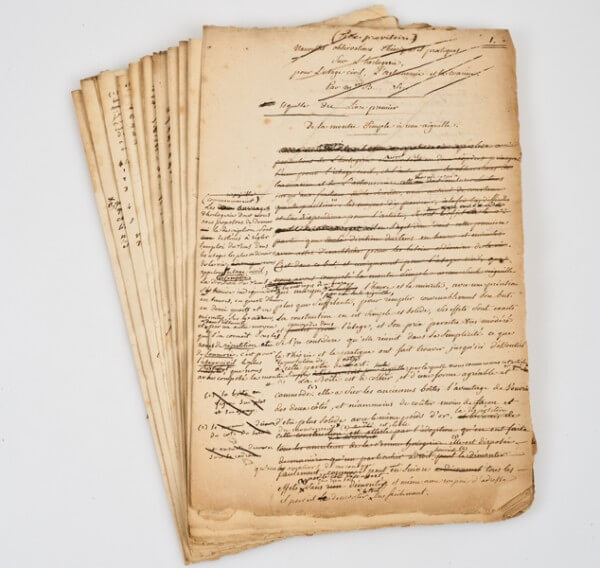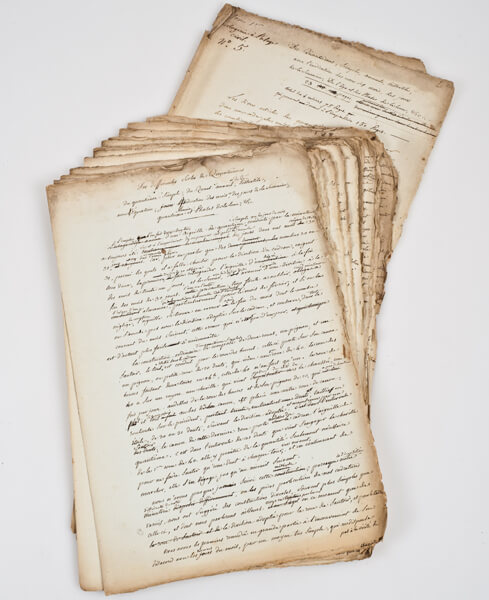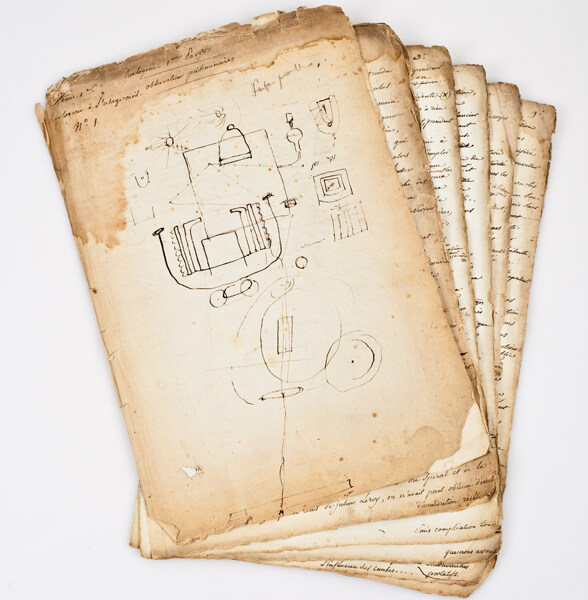Five years before his death Breguet began to set down his horological memoirs for posterity. He dictated all his horological experience, innovations and secrets to his assistant Louis Moinet. It was intended to be a book like no other that had ever been produced. Simply written, it offered in-depth explanations from which other watchmakers could learn and understand Breguet‘s secrets, and from which they could incorporate his experiences and ideas into their own work. The recent discovery of this work completely changes our understanding of the history of horology and our attitudes to and knowledge of watchmaking.
During the bidding, this historic Breguet manuscript was offered provisionally as seven separate lots, and from the outset it was clear from the number of bidders on the telephone and in the room who aggressively bid for the first lot in this manuscript group (lot 311), that history was about to be made. The bidding was feverish and fierce and quickly arrived at more than four times the lot’s initial estimate. This phenomenon was repeated with each lot in the manuscript group, with several of the lots, in particular lots 315 and 316, which cover Breguet’s thoughts on the tourbillion and Marine chronometers respectively, achieving more than eight times their initial estimate.
Since no one clear owner of the manuscript had emerged, the manuscript was then auctioned as one complete lot with the starting bid being the total of the provisional highest bids, so allowing the possibility of keeping the manuscript entire for posterity. Thanks to a total commitment and aggressive bidding, the Breguet museum ensured that this historic manuscript has finally returned home.
Lot 311
Breguet’s history and philosophy
Breguet, Paris, written between 1818 and 1823
This is a remarkable 24-page manuscript, with a drawing in which Breguet describes what he perceived to be the most important horological discoveries, he also writes about Graham and LeRoy. Breguet continues with aspects of the history of his firm, the history of different calibers starting with the history of single-hand watches (souscriptions), repeaters, unusual form watches, perpetuelles, Pendule Sympathique, etc. He writes about his marine chronometers and their philosophy. He mentions the invention of his balance spring. Then he continues with the philosophy of different styles – his cases and his dials – and lists his inventions and improvements. He also writes about the precision of his watches. Here for the first time Breguet mentions the word “isochronisms” and describes the idea and reasons for the tourbillon.
Dimensions: 35 cm x 23 cm
Lot 312
Single-hand watches and the new repetition
Breguet, Paris, written between 1818 and 1823
This is the original manuscript in which Breguet describes what he called “single-hand watches”, and we call souscription.
This 64-page manuscript is prefaced by a note on a small piece of paper, possibly written by the French police or a judge, explaining the source of these pages.
The manuscript is divided into four parts:
- De la montre simple à une aiguille
Here Breguet describes the philosophy and principles behind the Souscription. - De l’échappement à cyllindre en rubis, dans la montre simple, à une aiguille
Breguet elaborates on his famous ruby cylinder escapement. He analyzes the differences between this escapement and the Graham construction and detail s its materials and construction. - De la répétition par le tact
Here elaborates on the origin of his invention of the “Montre à tact” and compares it with repetition watches and describes the mechanism of his Montre à tact in great detail. - Cadrature for “répétition à trois vis”
An important chapter dealing with his new type of repeating mechanism which he invented for his new caliber watches. Breguet lists the advantages of this system and technical description of the system. He also explains why he called it “répétition à trois vis”.
Dimensions: 31 x 20 cm

Lot 313
The souscriptions and the repeating mechanisms
Breguet, Paris, written between 1818 and 1823
This is the final manuscript in which Breguet describes his souscription watches, their beginnings from a historical point of view, as well as a detailed technical description
The 92-page manuscript is divided into four parts:
- De la montre simple à une aiguille
Breguet talks here about the philosophy and principles behind the single hand watch, today known as the Souscription. - De l’échappement à cylindre en rubis, dans la montre simple, à une aiguille
Breguet elaborates in detail on his famous ruby cylinder escapement and analyzes the differences between this escapement and the Graham construction. - De la répétition par le tact
He elaborates here about the origin of his invention of the “Montre à tact” and compares it to repetition watches and describes the mechanism of his Montre à tact watches. - Cadrature for “répétition à trois vis”
An important chapter dealing with his new type of repeating mechanism which he invented for his new caliber watches.
Dimensions: 35 cm x 23 cm
Lot 314
Perpetuelles and their repetitions
Breguet, Paris, written between 1818 and 1823
In this 28-page manuscript, Breguet deals with his perpetuelle watches and gives a detailed description of the philosophy of his new repeating system which he invented for the purpose of employing in his perpetuelle watches.
The manuscript addresses the differences between the repeating system for simple watches and perpetuelles including the all-or-nothing system, activation. This is the fundamental work on the Breguet minute repeating system found in all his perpetuelles from the new series.
Dimensions: 35 cm x 23 cm
Lot 315
Equation of time, calendars, and tourbilons
Breguet, Paris, written between 1818 and 1823
A landmark 52-page manuscript in which Breguet describes the ideas behind his calendar and equation of time watches and clocks, and goes into very precise detail describing their variations and mechanisms. Breguet also includes here an essay on tourbillions. In the second part Breguet mentions that he submitted at least two pieces to the Paris Observatory for testing. For the first time he mentions montre à longitudes.
He compares some of his watches to watches from other establishments and gives the price comparison. He also describes his jump-hour mechanism.
It is part of Horlogerie à l’usage civil and consists of the following chapters:
- Des Quantièmes, Simples, annuels, bissextiles, avec l’indication des noms des mois des jours de la semaine, de l’âge et des phases de la lune, &c.
Breguet begins the manuscript with the old, simple calendars and explains why he changed to the new system. He talks about annual calendars, equation of time and its cam and goes into detail regarding its mechanisms. He inserts here an essay about tourbillions and the history of an important tourbillion he began in 1802 and finished in 1813. Breguet introduces the perpetual calendar idea and describes in detail an annual calendar with his solutions to show 30, 31 and 28 days. He also elaborates on the perpetual calendar including leap year. - Des différentes sortes de Quantièmes; du quantième annuel et du quantième bissextile, avec l’équation, l’indication des mois et des jours de la semaine; quantième lunaire et phases de la lune, &c.
Breguet continues here with his calendars and equation of time mechanisms and concentrates on the differences. - D’un quantième annuel, avec équation exécute dans une montre, pour Mr. de Sommariva
Breguet describes in this chapter a magnificent watch which was ordered by Monsieur de Sommariva. The watch featured an annual calendar, equation of time, with chronometer spring detent escapement. He also describes the very famous tourbillion clock sold to Monsieur Sommariva, the clock which later was destroyed in the fire of the Sommariva’s palace. He describes the watch as the highest achievement ever made before 1813 in the Art of Horology and still in existence. In the last part of this chapter Breguet describes another important watch with a dial on each side, equation of time and perpetual calendar he made in the late 18th century and sold to Duc de Praslin. - Du quantième des jours du mois et de la semaine
Breguet elaborates here on the type of dials he prefers for his simple calendars and describes his solutions. Surprisingly, he also describes here his jump-hour mechanism found in most of his high quality repeaters. He also writes about his special dials.
Dimensions: 35 cm x 23 cm

Lot 316
Marine horology
Breguet, Paris, written between 1818 and 1823
Des Horologes Marines
Des horologes marines, des montres à longitudes, &c.
Réflexions préliminaires
Breguet starts this, 32-page manuscript, by showing the importance of marine horology. There are many corrections made in his own hand. He describes the problems a marine horologists faces and elaborates on his vision to build longitude horology on different, simpler principles. He continues with a description of his vision and gives technical details about the construction of his marine chronometers. He describes the problems of the oxidation the marine timepieces are subjected to while on the high seas, the oil quality problems, temperature compensation, and others. He elaborates on additional mechanisms found in marine timepieces, he reveals his secrets for keeping constant momentum on the train, and on the use of a fusee versus two barrel system. There is also a drawing and explanation in Breguet’s own hand of his echappement naturel. He compares it to the spring detent escapement.
Dimensions: 35 cm x 23 cm
Lot 317
Marine chronometers, montres a longitude, breguet balance spring
Breguet, Paris, written between 1818 and 1823
In this, 62-page manuscript, Breguet describes Marine Chronometers, montres à Longitudes, and many of his designs and inventions.
The manuscript is divided into six chapters:
- De l’échappement de l’horloge marine
Here Breguet describes the spring detent escapement and interestingly credits Dutertre as the inventor. He writes that it was improved by Arnold and now is called Arnold escapement. He goes into great detail describing how the escapement works. - Des engrenages
Breguet describes in detail how the train should be designed and constructed. He elaborates on the theory of gearing and describes the shape of the teeth, and gearing. He mentions Huygens, Berthoud, and Camus and their roles in the improvement of the gearing. Then he continues showing how to reduce friction, and the role and size of the pivots. He elaborates on his escape wheel for chronometers, discusses its inertia problem and includes comparisons of escape wheels by other makers, he also expresses his opinion on verge watches. - Des pivots
In this chapter Breguet discusses the quality of steel and describes how to make the pivots and tools used. He discusses ruby jewels, the role of dust on both the pivots and the jewels, the role of oil, and the role of endstones. He describes the parachute shock absorbers and their role on the pivots, describing this invention of his as a “real improvement”. He reveals, previously unknown, that he invented cone pivots and describes them in great detail. - De l’échappement
Here, Breguet compares the role of well-finished pivots for the precision of a watch and the role of the escapement. He goes into detail listing the causes for escapement irregularities, including among others the air resistance and the inner molecular friction of the balance spring. This is a remarkable paragraph from which we see the depth of Breguet’s comprehension, even on the molecular level; he even uses the word “molecules” in discussing his work.
He explains other causes of rate irregularities. Then he discusses in great detail the chronometer detent escapement, the materials used, the jewelling, the impulse and discharging jewels, and the role of oil in the escapement, from which we learn some surprising facts never thought of before. - Du spiral
Breguet starts this chapter with a statement on how important it is to have an isochronous balance spring with good temperature compensation. He explains in detail the theory behind isochronisms. He gives Pierre LeRoy credit for certain discoveries, noting that Harrison, Sully, and Mudge did not expect them. He describes different shapes of balance springs such as cylindrical, conical, etc. and expresses his preferences.
He continues with detailed description of the springs he used for his marine chronometers. He explains the theoretical principles behind the Breguet Balance Spring. He describes in detail the collet and the stud and he elaborates on adjustments. The next part is devoted to how he made the balance springs, the heat treatment, the polish, etc. - De la compensation
Breguet begins by explaining the effects of the temperature on the diameter of the balance and other variable conditions affecting the rate of a chronometer. He gives Harrison credit for discovering a method of correcting the temperature irregularities. Breguet continues the chapter describing how he made compensation balances and theorized on the lamina’s thickness. He ends this chapter with how he adjusts bimetallic balances with screws and weights.
He summarizes the chapter by stressing that all he has written about marine timepieces shows how difficult it is to adjust them and that still more research is needed in this area.
Dimensions: 35 cm x 23 cm ■
















